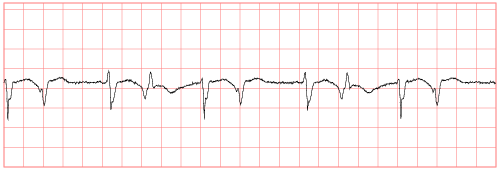
The files in this set can be used for testing a variety of devices that monitor the electrocardiogram. The recordings include both synthetic and real waveforms. For details on these test waveforms and how to use them, please refer to section 5.1.2.1, paragraphs (e) and (g) in the reference below.
Each recording contains one ECG signal sampled at 720 Hz with 12-bit resolution. The recordings can be viewed or converted to text form using the PhysioBank ATM, or read directly using the WFDB Software Package. The record names refer to the illustrations in the reference below (figures 3 and 4 on pages 25 and 26 of that document). Note that EC13 specifies that the tachycardia waveforms in figure 4 should be presented following an abrupt transition from synthetic waveforms specified in figure 6 of EC13; thus the aami4* records each begin with 30 seconds of triangle waveforms, followed by the figure 4 waveforms. The records named aami4a_d and aami4a_h, etc., contain the half-size and double-size versions of the figure 4 data that are mentioned in the standard. (The names are misleading, since the _d records contain the half-size versions, and the _h records contain the double-size versions, the opposite of what the record names imply. The names are those given by AAMI, the source of these files, and they have not been changed, in hopes of avoiding further confusion. Thanks to Humberto Valdes for pointing out this issue.)
In addition to these waveforms, EC13 specifies the use of specific synthesized waveforms that can be created using the ECG waveform generator for Matlab/Octave available in PhysioToolkit.
Reference
Cardiac monitors, heart rate meters, and alarms [American National Standard (ANSI/AAMI EC13:2002)]. Arlington, VA: Association for the Advancement of Medical Instrumentation, 2002.
Name Last modified Size Description
Parent Directory -
aami4b_d.dat 2002-12-19 11:37 127K digitized signal(s)
aami4b.dat 2002-12-19 11:37 127K digitized signal(s)
aami4b_h.dat 2002-12-19 11:37 127K digitized signal(s)
aami4a_d.dat 2002-12-19 11:36 127K digitized signal(s)
aami4a.dat 2002-12-19 11:36 127K digitized signal(s)
aami4a_h.dat 2002-12-19 11:36 127K digitized signal(s)
aami3c.dat 2002-12-19 11:36 84K digitized signal(s)
aami3b.dat 2002-12-19 11:36 84K digitized signal(s)
aami3a.dat 2002-12-19 11:36 84K digitized signal(s)
aami3d.dat 2002-12-19 11:36 67K digitized signal(s)
SHA256SUMS 2007-09-18 12:36 1.8K
SHA1SUMS 2005-07-12 20:03 1.1K
MD5SUMS 2005-07-12 20:03 916
aami4b_h.hea 2002-12-19 11:37 106 header file
aami4a_h.hea 2002-12-19 11:37 105 header file
aami4b_d.hea 2002-12-19 11:37 104 header file
aami4a_d.hea 2002-12-19 11:36 104 header file
aami4b.hea 2002-12-19 11:37 99 header file
aami4a.hea 2002-12-19 11:36 99 header file
aami3a.hea 2002-12-19 11:36 97 header file
aami3d.hea 2002-12-19 11:36 96 header file
aami3c.hea 2002-12-19 11:36 96 header file
aami3b.hea 2002-12-19 11:36 96 header file
RECORDS 2002-12-19 13:01 78 list of record names
DOI 2015-09-21 13:00 19
|
If you would like help understanding, using, or downloading content, please see our Frequently Asked Questions. If you have any comments, feedback, or particular questions regarding this page, please send them to the webmaster. Comments and issues can also be raised on PhysioNet's GitHub page. Updated Friday, 28 October 2016 at 16:58 EDT |
PhysioNet is supported by the National Institute of General Medical Sciences (NIGMS) and the National Institute of Biomedical Imaging and Bioengineering (NIBIB) under NIH grant number 2R01GM104987-09.
|